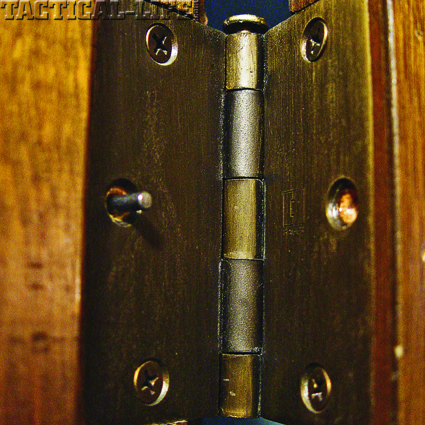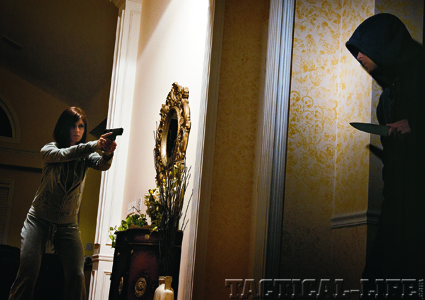According to a report by the United States Department of Justice, 38 percent of assaults and 60 percent of rapes occur during home invasions. Although home invasion is not defined as a specific crime in many states, as a criminal practice, it is becoming increasingly prevalent. Previously, businesses, banks, and similar commercial institutions were the targets of choice for criminals because they held the promise of bigger payoffs. However, as security measures at these businesses have improved, targeting them has gotten increasingly difficult. This has made family homes a very attractive alternative for criminals.
While most people would like to believe that the solution to a home invasion is just a 911 call away, it’s not that easy. According to research done by the Atlanta Journal Constitution on police response times in major metropolitan areas, it typically takes at least 10 minutes for police to respond to a high-priority emergency call. Atlanta, which had the slowest response time of the seven cities studied, took on average 11 minutes and 12 seconds from the time a high-priority 911 call was received until a police officer arrived at the scene. A lot of bad things can happen to you and your family in 11 minutes. Even worse things can happen if you never have the opportunity to make that call.

Average police response time in major metropolitan areas is 11 minutes and 12 seconds. A lot can happen in that time — are you prepared to handle it? Sean Utley Photo.
Advertisement — Continue Reading Below
One of the best ways to ensure that your family can survive a home invasion is to develop a sound home security plan that includes external physical security, a strong safe room within the house, and good security-conscious habits.
Safe Room Basics
The first priority in keeping your family safe should always be to invest in the external security of your home. Strong physical barriers and warning systems, while not perfect, will make getting into your home much more difficult. If they don’t completely deny access to the criminals, they will slow them down significantly and make their efforts to get in louder and more obvious. That gives you time to react.
Advertisement — Continue Reading Below
A safe room is basically a reinforced room within your home where you and your family can secure yourselves in the event of a home invasion. It provides physical security to keep the invaders out, provides the resources you need to call for help, and serves as a stronghold from which you can defend yourself with force if required.
Typically the master bedroom is the most logical choice for a safe room, but this may vary according to the layout of your home, its physical structure, and the way your family members are typically positioned within your home.
Like the external doors to your home, your safe room door should provide a solid physical barrier to keep intruders out. Although it may not do so permanently, it should be strong enough to allow you time to call for help and gather the resources to defend yourself. Safe room door features should include:
Advertisement — Continue Reading Below
• Solid core: Hollow core or paneled doors can be easily defeated with a strong kick. Your safe room must have a high-quality solid-core door.
• Multiple hinges: Your safe room door should be hung on at least three, preferably four high-quality hinges. These hinges should be attached to the door and the frame with three-inch or longer wood screws or deck screws. This way the door is securely anchored into the actual wall structure, not just the doorjamb.
• Pinned hinges: Your safe room door should open inward, so there are no exposed hinges that a home invader could attack. Whether it opens inward or outward, the hinges should be “pinned” by replacing one screw of each hinge with a “hinge stud” that extends about 3/8- to 1/2-inch out from the hinge plate and nests into the screw hole on the opposite hinge piece. Alternately, you can use a nail, wood screw or lag screw that is screwed in only part way, leaving part of the screw shank protruding. Cut off the head of the screw at the proper length and you achieve the same goal, which is to make it impossible to lift the door off the hinges, even if the hinge pins are removed.
Advertisement — Continue Reading Below

Pinned hinges prevent the door from being lifted off its hinges and are a must for outward-opening doors. One screw is replaced with a nail or screw that extends through the matching hole in the other hinge plate.
• Deadbolt: A safe room door needs to have a high-quality deadbolt lock or, even better, two of them—one above and one below the knob. The lock area of the door should also be reinforced with a metal wraparound sleeve.
• Reinforced strike plates: To ensure that the deadbolt does its job, the bolt must nest into a strong anchor in the doorframe. A reinforced strike plate is much longer than a standard strike plate, includes more screw holes for mounting, and when installed with extra-long screws, is anchored to the solid wood of the wall structure.
Advertisement — Continue Reading Below

Your safe room door should be of solid-core construction, have at least one deadbolt lock, and have a reinforced strike plate. This extended plate is installed with long screws that anchor to the wall frame around the door.
• Peep hole: Ideally, you should be able to look out of your safe room to see if an intruder is still in the hallway. A one-way peephole is therefore a good idea. If you are forced to use the safe room, resist the urge to look out of the peephole until you know it is safe to leave the room (after the police have arrived). Your presence behind the peephole could allow an intruder to target you with a firearm through the door.
Safe Room Furnishings
Advertisement — Continue Reading Below
The critical items you should have in your safe room include the following:
• Cell phone and charger: Even if you have a landline phone in your safe room, don’t assume that you’ll be able to use it during a home invasion. While most criminals won’t cut the phone lines the way they do in the movies, they will often take a phone extension off the hook elsewhere in the house to prevent you from calling out.
Advertisement — Continue Reading Below
• Written emergency script: During the terror and stress of a home invasion, simple tasks like telling the emergency operator your name and address can be difficult. To ensure that you can say everything you need to say, prepare a script in advance. Print it out in large, easy-to-read print, laminate it, and keep it with your emergency cell phone. This script will “remind” you to explain that you are calling on an emergency cell phone and will provide a clear summary of the situation, your address, your specific location within the house, and the fact that you are armed and in fear for your life. It will also remind you to mention who is with you in the safe room and what you are wearing.
• Firearm, ammo, and flashlight: Anyone who enters your home and is willing to deliver violence to you and your family will not respond to anything less than more effective and more committed violence. If he or they get through that door, you need to be prepared to defend yourself. A firearm, properly selected ammunition, and proper training allow you to do that. You should also have a high-intensity tactical flashlight and the skill to use it and your firearm together.
• First aid kit: It is possible that you or a family member could suffer an injury on the way to the safe room. A well-stocked first aid kit should therefore also be part of your safe room resources.
Advertisement — Continue Reading Below
• Spare keys: When the police arrive, you want them to be able to enter the house and ensure that it is safe before you leave your safe room. The easiest way to do this is to have an extra set of house keys that you can throw out a window to them. By attaching a light stick to the key ring, the officers can easily find them if you throw them into the grass or bushes.
• Alarm Keypad: If you can invest in an alarm system, do it. When it’s installed, ensure that one of the control keypads is located in your safe room and learn how to use it properly—including how to manually activate the alarm if you need to.
Cover and Backstops
One often overlooked aspect of planning a safe room planning your fields of fire. Basically, this comes down to three elements: having cover for yourself and your family, being able to engage threats from that cover if they enter the doorway, and having a solid backstop behind the area you’ll be shooting into.
Cover is something that will actually stop incoming gunfire. If a home invader has a firearm and shoots through the door or wall, you and your family should be behind something that will stop those bullets. Unfortunately, the construction of most homes, as well as the beds, mattresses, dressers, and other stuff likely to be in your safe room, won’t even stop small-caliber handgun bullets. Your best bet is to strategically place something that constitutes real cover in your safe room.
Since part of the goal of a safe room is secure storage of defensive firearms, having a gun safe in that room makes very good sense. A full-size steel gun safe with an open door can literally provide enough cover for you, your spouse, and a couple of kids and makes a great “centerpiece” for your safe room defense strategy.
To figure out where to put that safe, think about firing rounds from various locations in your safe room toward the doorway. Then look beyond the door area and figure out where those rounds would go if they went through your attacker or missed him entirely. The goal of this process is to determine angles of fire that allow you to shoot effectively and ensure that any rounds that don’t stop in your attacker come to rest in something appropriate. The ideal choices for solid backstops would be things like fireplaces, stone walls, or brick façades. If these are not available, strategically placed bookcases also make great bullet stops.
A Reaction Plan
The final phase of implementing your safe room plan is to develop and rehearse a reaction plan that gets everyone into the safe room quickly and efficiently. Basically a “reverse fire drill,” this process should start with a simple, clear, verbal command like “Safe!” or “Safe Room!” On that command, everyone should immediately move into the safe room, do a head count, lock the door, and get behind cover. You should then access your firearm, phone, and script and be prepared to call 911. From that position of safety, remind yourself that you are prepared to defend yourself and your family with the benefit of well-planned fields of fire and reliable backstops.
Check out our article: Partner Up for Home Defense with Gunsite’s Team Tactics Course


























